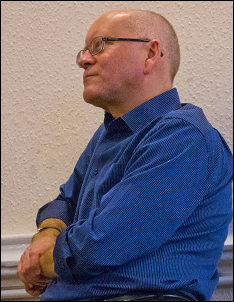|
Dr Alan Crosby – Preston Guild - a history of England's greatest
carnival
Tue 12 June 2012 |
|
Historian, Alan
Crosby, wrote the official record of the Preston Guild before
the 1992 event.
Alan took us right back to the 12th century to when Preston was
granted its first borough charter. This granted by Henry II in
1179 when Preston had a population of less than 1,000 people. A
small community but with Preston’s geographic position an
important one.
Preston was one of the first towns’ granted a charter but it
does not exist now. However, what it said is known as it is
based on the charter granted to Newcastle-under-Lyme,
Staffordshire. Preston’s was a royal charter where the Crown had
granted privileges. Other places granted the same included
Kendal, Liverpool, Carlisle and Wigan. |
|
The Guild
Merchant was actually a brotherhood of men, it was a male
preserve until 1992, who were involved in business and share a
common interest. If you were not a member then you could not
conduct business in Preston as it was effectively a ‘closed
shop’. Penalties for contravention included an order to cease\to
trade, fines and confiscation of stock in trade and tools of
trade. These, naturally, would be distributed amongst the
members.
There appears to be evidence of only occasional guilds held up
until the end of the 15th century. It was the guild of 1397 that
first recorded a list of the members of the Guild Merchants.
From 1522 onwards though the Guild fell into a pattern of being
held every 20 years. This was probably due to that time span
fitting into a generational cycle. Membership was based on a
hereditary principal and fathers passed it onto their sons. The
now extinct Kendal guild occurred every 21 years. |

Alan Crosby |
Although members protected their own trade men could buy into
the membership, especially if you ran a trade that was not in
competition to the town’s traders. This was a way of bringing
new blood into town.
It was not until the 18th century that there was a surge in
membership. Not of traders but of Lancashire’s gentry,
aristocracy and clergy. It was the 1742 guild procession that
saw the trade element became secondary to the civic.
It was the 1802 guild that experienced a dramatic change and one
that was crucial to its future success.
This was due to one man, John
Horrocks. Horrocks was the town’s largest employer owning
several cotton mills and was the town’s richest man. He was also
one the town’s 2 MPs. However, this power also made him the most
hated man in town. He was though a great self-publicist and took
the opportunity to ‘showcase’ his mills and their products. He
headed the procession, arm in arm with the town’s other mill
owners with their workers following behind.
This Guild saw much wider people participation with involvement
of merchants, traders, civic, church and Sunday schools.
Despite ebbs and flows in the Guild’s success, mainly caused by
the economic climate of the day, it still continues. This year
sees the latest one but because of council budget cuts it will
be a more modest event than more recent ones. It will, no doubt,
be eagerly awaited for Prestonians to celebrate their historic
Guild.
Peter Robinson |
|